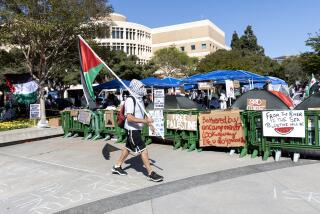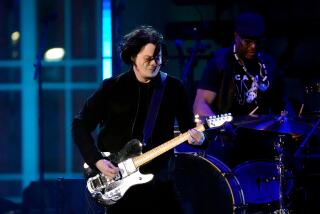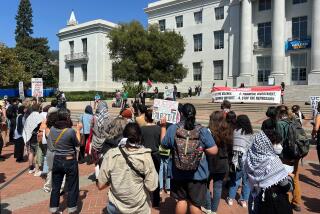Cal Poly Ends Annual Fest; Blames Rioting
SAN LUIS OBISPO — An annual college festival at Cal Poly that began in 1933 was canceled indefinitely Monday by campus officials after a weekend of rioting that led to about 110 arrests and caused more than 100 injuries.
After a meeting Monday of San Luis Obispo civic leaders, campus officials and students, university President Warren Baker announced that the festival--called Poly Royal--will be canceled next year. Its future then will be reviewed. And if Poly Royal is ever held again, campus officials said, it will be much smaller with a more academic orientation.
The decision to cancel the festival came in response to a weekend that San Luis Obispo Mayor Ronald Dunin called “the worst experience in the history of San Luis Obispo . . . even during the 1960s we never had any problems like this.”
A spokesman for the city’s business community, however, questioned the decision.
Because Poly Royal has proved so lucrative for the local business community, many merchants were disappointed by the festival’s cancellation, said David Garth, head of the San Luis Obispo Chamber of Commerce. The festival draws more than 100,000 visitors to this city of about 41,000 residents, and generates an estimated $3 million to $5 million in business revenue, Garth said.
“I’m sorry they made such a quick decision in the emotion of the moment,” he said. “I wish they’d have taken a little longer to discuss the situation.”
But Dunin said city officials and campus leaders will meet soon to discuss possible alternatives to Poly Royal.
“I hope we can still have a festival . . . but one that is educational and cultural and avoids all these problems,” Dunin said. “It’s important to have these activities so students who are interested in enrolling at the school, their parents and other people have the chance to enjoy the campus for a few days.”
When Cal Poly was a small agricultural college in the 1930s, Poly Royal was billed as a “country fair on a college campus.” But now Cal Poly is a major university of 17,000 students. And, among off-campus celebrants, the festival has grown into a rowdy weekend of partying that attracts youths from throughout the state.
This year’s riots broke out after various campus events had ended. On both Friday and Saturday nights, youths clashed with police, throwing bottles and rocks until they were dispersed with tear gas and high-pressure water hoses.
About 100 youths were treated at local hospitals during the weekend rioting, authorities said. One Cal Poly student suffered a head injury and remained in serious condition Monday at a local hospital. Also injured in the rioting were 12 police officers--including one who suffered a broken arm and another whose wrist was fractured.
The riots occurred in an area near campus where many students live. Numerous buildings in that area were damaged during the riots and Dunin estimated the cost to the city at “several hundred thousand dollars.”
About a dozen students complained to university officials that police used “excessive force” in quelling the disturbances, said campus spokesman Stan Bernstein. But at a news conference Monday, San Luis Obispo Police Chief Jim Gardiner defended his officers, saying “the response was appropriate, measured and restrained.”
After the disturbance Friday night, which involved more than 1,000 youths and resulted in about 30 arrests, police geared up for problems Saturday. By about midnight, a crowd of 2,000 had gathered at an intersection near the campus and began throwing bottles into the street, breaking car windows and setting bonfires. It took about two hours for 120 officers, in full riot gear, to clear the streets. About 80 youths were arrested.
Most of those arrested had been released from jail by Monday. Charges against those arrested ranged from failure to disperse, a misdemeanor, to felony assault on a police officer.
More to Read
Sign up for Essential California
The most important California stories and recommendations in your inbox every morning.
You may occasionally receive promotional content from the Los Angeles Times.










